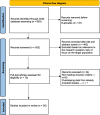The diagnostic and predictive accuracy of the PRISMA-7 screening tool for frailty in older adults: a systematic review, and meta-analysis
- PMID: 40490744
- PMCID: PMC12147269
- DOI: 10.1186/s12877-025-06094-2
The diagnostic and predictive accuracy of the PRISMA-7 screening tool for frailty in older adults: a systematic review, and meta-analysis
Abstract
Background: Frailty is associated with adverse outcomes in older adults across healthcare settings. Frailty screening tools can serve to identify older adults living with frailty and direct resources to high-risk older adults. This systematic review and meta-analysis examined the diagnostic and predictive accuracy of the Program of Research to Integrate the Services for the Maintenance of Autonomy 7 (PRISMA-7) frailty screening tool.
Methods: A systematic literature search was conducted in PubMed, EMBASE, CINAHL, EBSCO and the Cochrane Library. Prospective or retrospective cohort and cross-sectional studies that explored the diagnostic and/or predictive accuracy of the PRISMA-7 tool in older adults were included across all healthcare settings. Study quality was assessed using the QUADAS-2 tool. Statistical analysis was completed using Stata version 12 (StataCorp, TX, USA). A bivariate random effects model was used to generate pooled estimates of sensitivity and specificity. RevMan5 was used to pool data comparing older adults living with frailty versus those without frailty.
Results: Thirty-six studies were included in the review. The overall quality of the studies included was moderate. Meta-analysis of diagnostic accuracy (regardless of reference standard used) showed a pooled sensitivity and specificity of 72% (95% CI 54-84%) and 87% (95% CI 76-93%), respectively. Sub-analysis of the six studies that used Frailty Phenotype as a reference standard demonstrated pooled sensitivity and specificity of 82% (95% CI 73.8-88.2) and 79% (95% CI 72-85.6%), respectively. Meta-analysis of the predictive accuracy of the PRISMA-7 showed that older adults living with frailty spent significantly more time in the emergency department (FEM MD 2.66 h, 95% CI 2.15-3.16 h, I2 = 25%) and stayed longer in hospital, (REM MD 1.89 days, 95% CI 0.18-3.6 days, I2 = 86%), respectively.
Conclusion: The PRISMA-7 has a moderate sensitivity and high specificity for frailty identification. It has good predictive accuracy for multiple adverse outcomes among older adults, supporting its potential utilization across healthcare settings.
Keywords: Frailty; Older adults; PRISMA-7; Screening.
© 2025. The Author(s).
Conflict of interest statement
Declarations. Ethics approval and consent to participate: Not applicable. Consent for publication: Not applicable. Competing interests: The authors declare no competing interests.
Figures







Similar articles
-
Diagnostic Accuracy of the FRAIL Scale, Groningen Frailty Indicator, Tilburg Frailty Indicator, and PRISMA-7 for Frailty Screening Among Older Adults in Community Settings: A Systematic Review and Network Meta-Analysis.Gerontologist. 2024 Jun 1;64(6):gnae008. doi: 10.1093/geront/gnae008. Gerontologist. 2024. PMID: 38332716
-
Comparative analysis of frailty identification tools in community services across the Asia-Pacific: A systematic review and meta-analysis.J Nutr Health Aging. 2025 Apr;29(4):100496. doi: 10.1016/j.jnha.2025.100496. Epub 2025 Jan 30. J Nutr Health Aging. 2025. PMID: 39889374 Free PMC article.
-
Cognitive Frailty as a Predictor of Future Falls in Older Adults: A Systematic Review and Meta-Analysis.J Am Med Dir Assoc. 2023 Jan;24(1):38-47. doi: 10.1016/j.jamda.2022.10.011. Epub 2022 Nov 21. J Am Med Dir Assoc. 2023. PMID: 36423679
-
Comparative Analysis of Frailty Scales in Emergency Department: Highlighting the Strengths of the Triage Frailty and Comorbidity Tool.J Emerg Nurs. 2025 Jan;51(1):135-144. doi: 10.1016/j.jen.2024.09.012. Epub 2024 Nov 5. J Emerg Nurs. 2025. PMID: 39503691
-
The Prevalence of Social Frailty Among Older Adults: A Systematic Review and Meta-Analysis.J Am Med Dir Assoc. 2023 Jan;24(1):29-37.e9. doi: 10.1016/j.jamda.2022.10.007. Epub 2022 Nov 17. J Am Med Dir Assoc. 2023. PMID: 36402197
References
-
- United nations department of economic and social affairs population division. World population ageing 2019: highlights (ST/ESA/SER.A/430); 2019.
-
- Aminzadeh F, Dalziel WB. Older adults in the emergency department: a systematic review of patterns of use, adverse outcomes, and effectiveness of interventions. Ann Emerg Med. 2002;39(3):238–47. 10.1067/mem.2002.121523. - PubMed
-
- Rochat S, Cumming RG, Blyth F, Creasey H, Handelsman D, Le Couteur DG, et al. Frailty and use of health and community services by community-dwelling older men: the concord health and ageing in men project. Age Ageing. 2010;39(2):228–33. 10.1093/ageing/afp257. - PubMed
-
- Lang PO, Michel JP, Zekry D. Frailty syndrome: a transitional state in a dynamic process. Gerontology. 2009;55(5):539–49. 10.1159/000211949. - PubMed
Publication types
MeSH terms
LinkOut - more resources
Full Text Sources

